It was just a regular summer away game for the Houston Astros, the last in a three-game series against the Seattle Mariners. Astros first baseman Tyler White hit a home run and skittered back to the dugout to celebrate. After White ran the gauntlet of high fives, he and a handful of his teammates whipped their heads around in a smooth, choreographed motion to level an intense, poker-faced stare on the watching TV cameras.
Before the game ended (with Houston defeating Seattle 10-7), clips of that perfectly timed dugout moment had already gone viral. More than 5,000 people ultimately retweeted a GIF of the stare uploaded by the Astros’ official account, and on Instagram, a still image with the caption “Dream Crushers,” posted by Astros infielder Alex Bregman, received more than 71,000 likes.
The buzz caught the attention of BreakingT, a “real-time sports apparel company,” whose designers immediately got down to the business of immortalizing the online ephemera into offline ink. Bregman’s Instagram photo was simplified and rendered in orange and white tones, offset by the navy T-shirt on which it was printed. Under the players’ portraits were two words: “Dream Crushing.” BreakingT, which has licensing deals with the Astros and other teams, sent an early proof of the art to the pictured players that evening for their feedback.
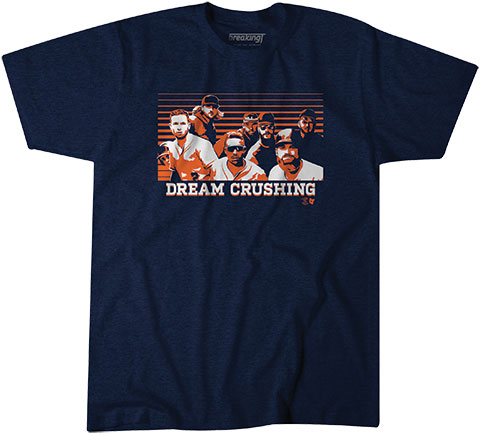
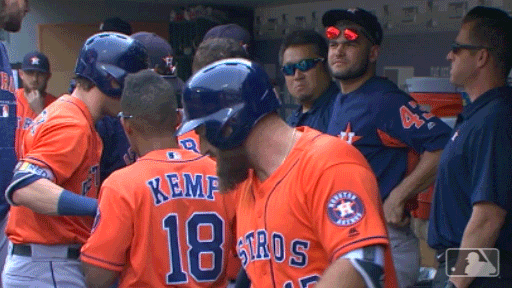
The following morning, BreakingT was selling the shirt online. “From the time the stare actually happened to when we designed the shirt and got it licensed and online, it only took 12 to 15 hours,” says Jamie Mottram, president of BreakingT. “It sold like crazy. The fans loved it because it was so fresh. It was a moment they loved, and they were still excited about it. That’s the dream scenario for us.”
Many apparel decorators are familiar with the rigors of stocking a hot market – pulling all-hands-on-deck overnighters to print thousands of shirts that will end up on retail racks the morning after a championship game. Those sorts of jobs are predictable, if harrowing. “There’s a World Series every year, and someone’s going to win, and that’s a big deal for us,” Mottram explains.
In the era of social media, however, a new kind of hot market has arisen, where the Twitterati latches on to fleeting moments in sports, politics or pop culture then relives and reimagines them in exhaustive threads of mashups, memes and GIFs. If successful, the trend has immediate heft: BreakingT’s “Dream Crushing” shirt was featured on the MLB Network, and several Astros members were spotted wearing the tee during batting practice.
Only a few of these fleeting events have a sustained lifespan. How many people are still talking about that marriage-wrecking black-and-blue dress? (Or was it white and gold?) Certainly not as many as in 2015 when the ambiguous photo first surfaced.
That’s almost beside the point. In the moment, nimble apparel decorators, using a delicately balanced alchemy of judgment, speed, creativity and marketing savvy, can transform the right viral trends from lead into gold. So what’s the formula for success in the world of “moment merch”?
Step 1: Spot the Trend
The first step is finding a viral moment that really resonates. Sports are a natural choice for moment-based merchandising because they’re passionately followed, broadly discussed live events where just about anything can happen. Consider the Cleveland Browns. After a 19-game streak (of losses), the Browns finally posted a come-from-behind win against the Jets in September. During that same game, a fan captured a possum in the FirstEnergy Stadium stands during halftime. As Sports Illustrated quipped on Twitter, “Anything is possumble.”
“It was a huge moment in sports,” says Kenneth Cashman, commissioner of Rotowear, an e-commerce apparel site geared toward fantasy sports aficionados. “But unless you’re following on Twitter or online, you wouldn’t even have known about the possum until it was too late to make a shirt.”
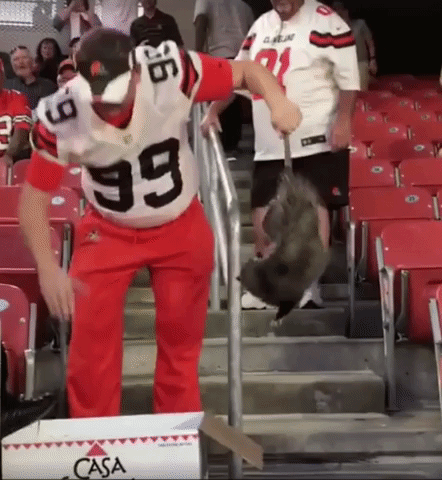
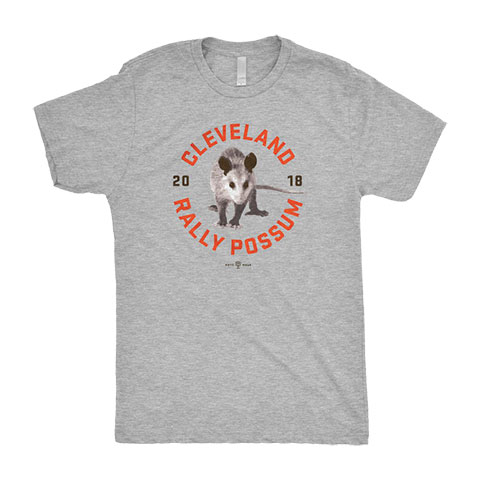
Rotowear created this T-shirt, after a fan found a possum in the stands at a Browns game.
One of those in the know, Cashman threw together a tee featuring a likeness of the lucky critter and the text: “Cleveland Rally Possum 2018.” The shirt was ready for on-demand digital orders the same night as the game. His design was picked up by local news sites, including Cleveland.com, “which helped dramatically with sales,” Cashman adds.
Politics, of course, is another arena that inspires strong emotions and team loyalties. “Donald Trump, love him or hate him, sells a lot of T-shirts,” says Philip Rooke, CEO of Spreadshirt, an online print-on-demand platform based in Germany. When the president speaks (or tweets), designers listen.
That was true even before he was inaugurated. Back in 2016, Amanda Brinkman was watching the presidential debates, when Trump called Hillary Clinton a “nasty woman.”
“I thought it would look good on a shirt, so I mocked it up in 10 minutes and put it on Instagram,” she says, noting that she also promised to donate half the proceeds to Planned Parenthood. The shirt’s design was simple: black text over a large pink heart. Brinkman was amused by the contrast between the inflammatory words and the saccharine image.
“I really thought I would sell three or four of them,” Brinkman recalls. “It was a very quick decision with no real strategy or development behind it. … I woke up to 10,000 orders.”
“If something happens – whether in sports or the news – and you don’t have a shirt out within a couple of hours, you’re already too late.” Kenneth Cashman, Rotowear
At the time a curator for an arts organization with no experience in the T-shirt business, Brinkman had to figure out on the fly how to get the unexpectedly large order produced and shipped. More than 30,000 Nasty Woman shirts have sold since Brinkman first posted her design, and she even launched an online business, Shrill Society, to market her Nasty Woman merchandise and other feminist apparel and products.
Success stories like Brinkman’s have an undeniable element of serendipity, but it’s tough to sustain a business on serendipity alone. To continually score viral hits requires a game plan. BreakingT execs, many of whom come from media backgrounds, run the apparel company like a newsroom, Mottram says. They closely monitor social data to identify emerging trends across a swath of sports leagues, merge that information with customer sales history, then use their own judgment to determine whether the trend in question is worth designing around. “We know the ebb and flow of things,” Mottram adds. “We know if something will have momentum or shelf life.”
Similarly, Fanatics, the country’s largest online sports retailer, uses a proprietary analytics platform that analyzes more than 200 variables, including the number of searches for any given player on its websites, sales data and clicks on specific jerseys in digital ads. The company even scrapes Facebook and Twitter to develop a “sentiment analysis” using natural language processing software, Matt Madrigal, Fanatics’ chief technology officer, told CNET in 2017.
Step 2: Beat the Rush
The second step in going viral is speed to market. “If something happens – whether in sports or the news – and you don’t have a shirt out within a couple of hours, you’re already too late,” says Rotowear’s Cashman. Uploading a hot design on your e-commerce platform is only half the battle. You also have to get the shirts printed and in customers’ hands while the moment is still top of mind.
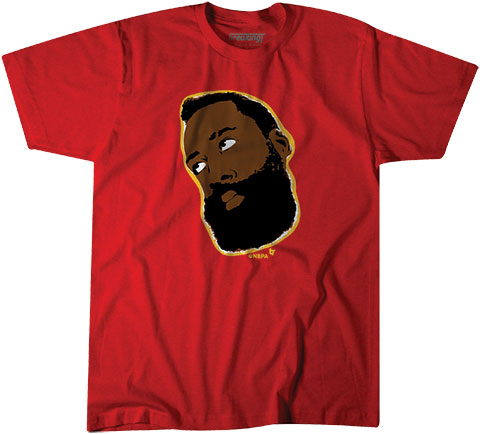

Breaking recreated Houston Rocket James Harden’s 2015 sideline interview side-eye on this tee.
Often, T-shirt designers and decorators turn to digital printing to handle these kinds of jobs. Direct-to-garment printers, for example, are known for lightning-quick setup times and low minimums, attributes that allow a decorator to stay nimble when faced with flash-in-the-pan opportunities, says Tim Check, senior product manager at Epson. “You can react extremely fast to any type of trend,” he adds.
DTG can also be a buffer against bad gambles. “People come up with cool designs that are really exciting for about a week, then they’re gone,” Check says. “Who knows if the new Grumpy Cat meme is going to take off or not? You can print as you go … and if the flash-in-the-pan opportunity goes away, you’re not sitting there stuck with a bunch of products that nobody wants anymore.”
Fanatics has invested millions into digital printing technology to capitalize on what it’s been calling “micro moments” in sports. “We live in an on-demand world,” Fanatics CEO Doug Mack told ESPN. “It’s not good enough to get the scores in the morning paper, and in the social media age we live in, fans want what they want.” On the delivery side, Fanatics has even partnered up with Uber Eats on a number of occasions to deliver coveted championship merch to impatient fans in a matter of minutes.
Not every company has gone completely digital, however. Traditional screen printing, paired with top-notch production workflow, can still be a viable option. BreakingT’s apparel is all printed by Sans Screenprint in Manassas, VA.
“People come up with cool designs that are really exciting for about a week, then they’re gone. Who knows if the new Grumpy Cat meme is going to take off or not?” Tim Check, Epson
“We release a new shirt and gauge the interest in the first 24 hours, then print a quantity to match the demand going forward,” Mottram says. “We’ll keep going back to print as long as there’s interest.”
After BreakingT launches a new design, “we can print within hours,” says Sixto Naranjo, a veteran decorator and owner of Sans. “By the next morning, we’re sending the shirts to our pick-and-pack team. … We ship everything out of here within 48 hours.”
Step 3: Make Your Mark
The third element of a viral success story is creativity and originality. It’s not necessarily about having the cleverest design, but you have to move the needle somehow and further the conversation.
Rooke, CEO of Spreadshirt, gives the example of CBS’ hit show The Big Bang Theory. Early on, designers would just slap character Sheldon Cooper’s catchphrase “Bazinga!” on a shirt and call it a day, but in addition to running up against copyright and trademark issues, it’s not very unique. A better shirt, he says, was derived from a specific episode where the same character consulted a trio of female friends, calling them his “council of ladies” and distributing commemorative pink tees with said phrase scrawled across the front. “Almost five minutes after airing, a version of that shirt was selling on our site,” Rooke says.
Another good example would be a designer who makes up a logo for a fictional restaurant frequented by the characters of her favorite TV show. “Fans won’t think it’s cool if you just copy something,” Rooke adds. “If it adds nothing new to the party, it never sells.”
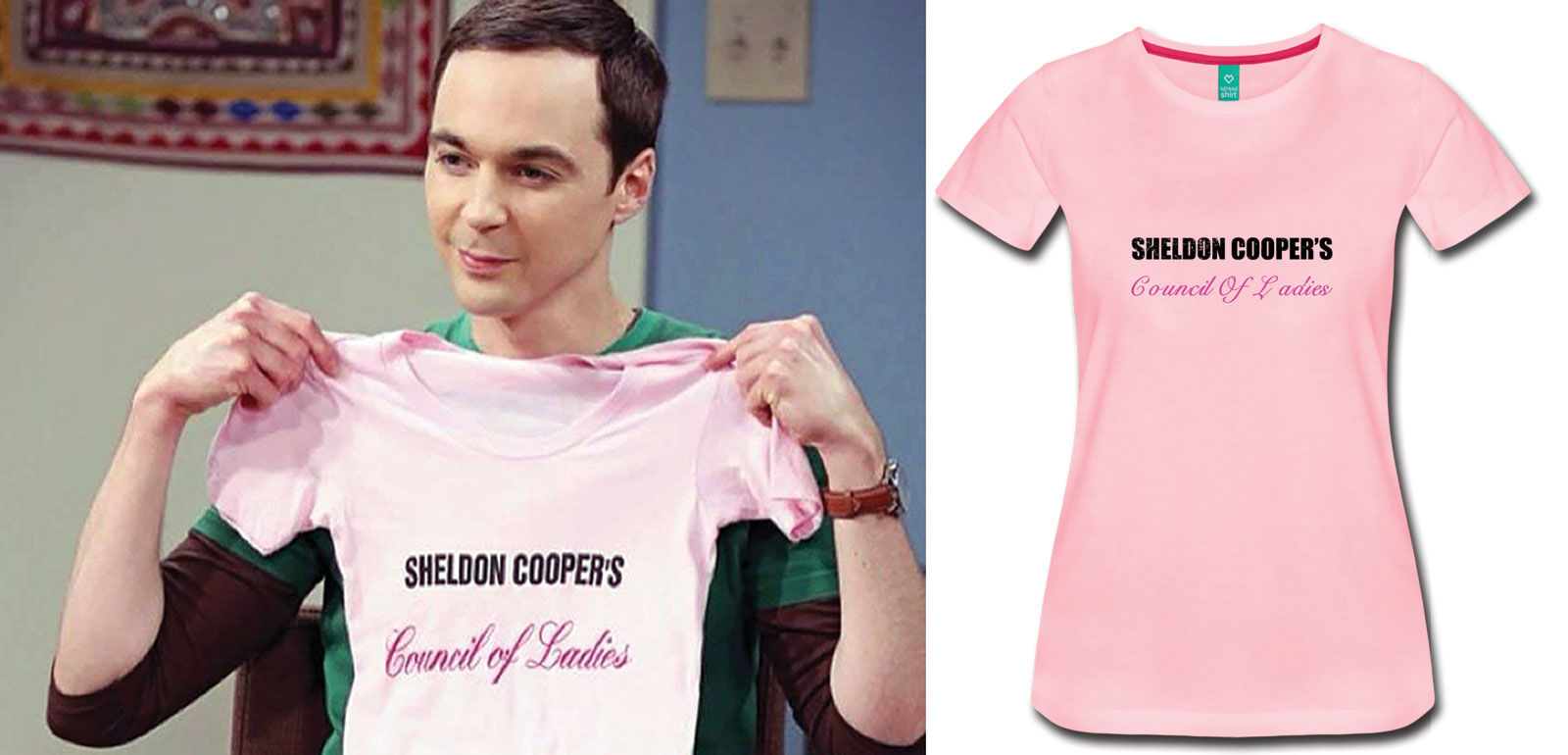
This Big Bang Theory T-shirt posted on Spreadshirt started selling minutes after a version of the shirt appeared on the show.
Cashman agrees. To go viral, “it has to be a funny shirt or good design,” he says. “At the end of the day, if something happens and you create a stale and vanilla design, it’s not going to matter that it gets shared on social or that it’s the first one out.”
Step 4: Attract Attention
Of course, getting shared on social is the ultimate goal for viral apparel – as long as those shares convert to sales. Other avenues for marketing moment merch include getting samples into the hands of influencers – an athlete, celebrity or even a local news station eager for fresh content.
Zome Design (asi/366115), a decorator in Spokane Valley, WA, has made a name for itself by focusing on hot market licensed collegiate apparel. “Anytime Washington State University, Eastern Washington University, Whitworth University or Gonzaga University hits it big in sports, we fire up the presses and crank out themed shirts,” says Owner Brayden Jessen.
Many of the shirts end up in area supermarkets and convenience stores. Zome also gets a lot of exposure thanks to its strong working relationship with local media. “They’re always looking for fun new clips they can add into their sports stories,” Jessen says. “We’ll get featured on their Facebook, Twitter, website and in the different nightly newscasts. It’s a great way for us to get free exposure.”
Back in 2013, for instance, Zome coined the term “Top Dog” for Gonzaga when it ranked #1 in the Associated Press’ Top 25 NCAA basketball poll. “That hit the media like wildfire, and we doubled our best month’s sales ever off that one term,” Jessen says. In late November, the Zags, as they’re known locally, reached the top spot on the AP’s list for the third time, and Zome was ready with “Third Time’s the Charm” and “Top Dog III” gear.
Part of the reason Brinkman’s Nasty Woman tee gained such notoriety was because celebrities like Katy Perry and Will Ferrell made purchases and wore the tees proudly during the 2016 campaign. “I definitely think celebrities wearing the shirt to canvass helped with sales,” Brinkman says. “But I didn’t do any outreach or follow up with them. I just like to respect their privacy.”
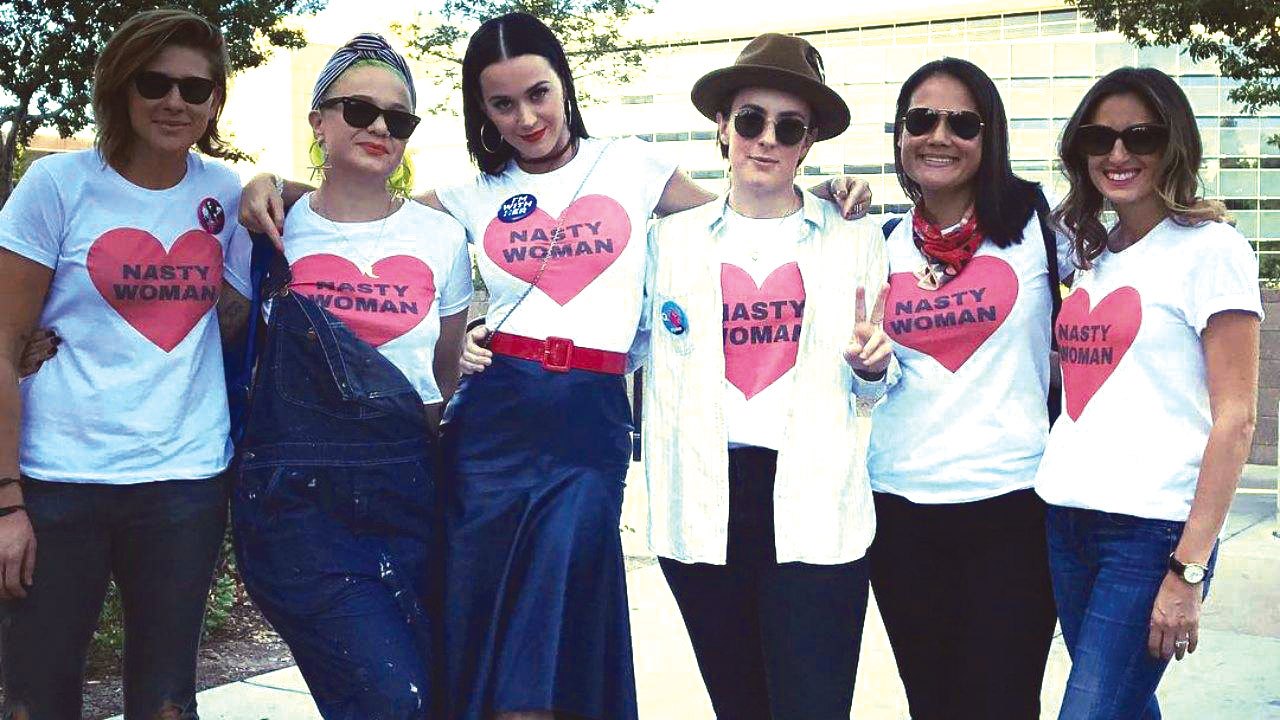
Amanda Brinkman’s “Nasty Woman” shirt for Hillary Clinton was a hit and caught the attention of celebrities like Katy Perry (center).
Cashman, on the other hand, has had some success with deliberate outreach efforts, randomly messaging athletes on social media about his latest shirts. “Believe it or not, it sometimes works,” he says. For example, Cashman designed a simple shirt, yellow text on green fabric, stating: “Big Al Hits Dingers.” Back in August, Little League star Al Delia went viral when he introduced himself with the phrase during a split-second interview on ESPN. Cashman sent his “Big Al” shirt to several Major Leaguers, who were subsequently seen wearing the tee on camera.
Sometimes, it just takes shelling out a few dollars on social media advertising. Blofish Clothing Co., a Louisville, KY, shop that specializes in gender-neutral activist-focused apparel, designed “I Believe You” T-shirts to support sexual assault survivors during the controversial nomination process for Supreme Court Justice Brett Kavanaugh. The small brand used its miniscule advertising budget to promote the tee on Facebook, and the response was huge, if sometimes negative. “We got a lot of kickback for it, but it’s what we believe as a company,” says Logan Manford, the founder of Blofish. In addition to hate mail, though, the brand received a lot of positive feedback. “We had one person break down when they saw someone wearing the shirt,” he says.
Step 5: Cross Your Fingers and Hope
The key point to remember when striving for a viral hit is that you can follow all the rules and still strike out. “I’ve had some designs I thought were home runs, but they didn’t really blow up, and some I threw out as not really even a thing, but just to have as content, end up making a lot of sales,” Cashman says. “Sometimes, there’s no rhyme or reason.”
The best advice from those who’ve gone viral is to narrow your focus to what you’re most passionate about, whether it’s sports, politics or even something as niche as breeding Cavalier King Charles spaniels. “People try to go viral in general, and it’s too large of a net to cast,” Brinkman says. “The shirts that are a little more authentic and resonate emotionally with people tend to be the ones that stick.”
